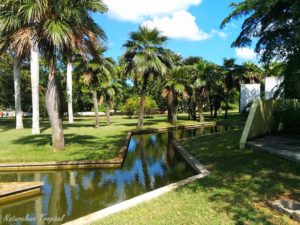The “Zaza” dam, the most important dam in Cuba, has been the site of an archaeological find that confirms the presence of a sixteenth-century aboriginal settlement.
According to local media, this place presents, due to the drought suffered by the island, its lowest level of water of the last three decades, a factor that has been decisive to materialize this discovery.
On the left bank of the Yayabo River, which ends at the “Zaza” dam, materials were brought in by the Spaniards during the conquest and colonization of the indigenous populations in this central region of the island, revealed the head of the Archaeological Office of the Office of Monuments and Historical Sites of the province of Sancti Spíritus, Orlando Álvarez de la Paz.
In this archaeological site were fragments of majolica pottery Columbia Liso and Caparra Azul, along with others of jars, two horseshoes and some nails, Alvarez de la Paz told Escambray newspaper in the province. The most important element of the collection was an iron spearhead, the only one of its kind found in sixteenth-century contexts in Sancti Spíritus. In the place there were portions of a clay disc, where the aborigines of Cuban farmers’ groups cooked, as well As elements of fishing nets and carved stone, along with other evidence of their presence on the site.
The specialists involved in the investigation indicated that the finding corresponds to the old hypothesis of historians who locate the founding point of the town of Sancti Spíritus, according to the cartography, between La Botella and Pueblo Viejo streams (today Puente Palo). Pointing out that it is just the enclave where evidential elements of the contact between Indians and Spaniards converged in the time in which they settled in that territory.
The Cuban archaeologist explained that in three previous expeditions to that area, carried out between April 30 and May 19, more than thirty new archaeological sites were located, almost half of which were aboriginal, while others contained Pieces of centuries between the XVII and the XIX.
He indicated that there are still other incursions to the flood basin of the Zaza dam, where there are “unexplored and potentially relevant” areas.
The Zaza reservoir, with a curtain of 3,300 meters long, 40 meters high exposed and a capacity of 1.020 million cubic meters of water, is at 11%, its lowest level of the last three decades and offers One of the most visible faces of the ravages is the severe drought affecting Cuba.
SEQUÍA EN PRESA CUBANA PERMITE ENCONTRAR ASENTAMIENTOS ABORÍGENES DE LOS AÑOS 1500s.
La presa “Zaza”, la más importante de Cuba, ha sido el lugar donde se producido un hallazgo arqueológico que confirma la presencia de un asentamiento de aborígenes del siglo XVI.
Según medios locales este lugar presenta, debido a la sequía que sufre la isla, su nivel más bajo de agua de las últimas tres décadas, un factor que ha sido decisivo para materializar este descubrimiento.
En la margen izquierda del río Yayabo, que desemboca en la presa “Zaza”, fueron encontrados materiales traídos por los españoles durante la conquista y colonización de las poblaciones indígenas en esta región central de la isla, reveló el jefe del Gabinete de Arqueología de la Oficina de Monumentos y Sitios Históricos de la provincia de Sancti Spíritus, Orlando Álvarez de la Paz.
En este sitio arqueológico fueron encontrados fragmentos de cerámica mayólica Columbia Liso y Caparra Azul, junto a otros de botijas, dos herraduras de caballo y algunos clavos, contó Álvarez de la Paz al periódico Escambray de la provincia. Como elemento más relevante de la colección resaltó una punta de lanza de hierro, única de su tipo hallada en contextos del siglo XVI en Sancti Spíritus.En el lugar aparecieron porciones de un disco de barro, donde los aborígenes de grupos agricultores cubanos cocinaban, así como elementos de redes de pescar y piedra tallada, junto a otras evidencias de su presencia en el sitio.
Los especialistas involucrados en la investigación indicaron que el hallazgo se corresponde con la vieja hipótesis de historiadores que sitúan el punto fundacional del poblado de Sancti Spíritus, según la cartografía, entre los arroyos La Botella y Pueblo Viejo (hoy Puente Palo). Señalando que es justo el enclave donde convergían elementos probatorios del contacto entre indios y españoles en la época en la que se asentaron en ese territorio.
El arqueólogo cubano explicó que en tres expediciones anteriores a esa zona, realizadas entre el 30 de abril y el pasado 19 de mayo, se localizaron más de una treintena de nuevas estaciones arqueológicas, casi la mitad de las cuales eran aborígenes, en tanto otras contenían piezas de siglos entre el XVII y el XIX.
Indicó que faltan por ejecutarse otras incursiones a la cuenca de inundación de la presa Zaza, donde hay áreas “inexploradas y potencialmente relevantes”.
El embalse “Zaza”, con una cortina de 3.300 metros de largo, 40 metros de altura al descubierto y una capacidad de 1.020 millones de metros cúbicos de agua, se encuentra al 11 %, su nivel más bajo de las últimos tres décadas y ofrece uno de los rostros más visibles de los estragos la severa sequía que afecta a Cuba.
Agencies/EFE/Internet Photos/Excerpts/Orlando Alvarez,Escambray/ Arnoldo Varona/ TheCubanHistory.com
THE CUBAN HISTORY, HOLLYWOOD.









